Having disorganized furniture responds to psychological motivations that vary according to the type of objects and people.
The Dissal drawers reveal psychological aspects and emotional of their owners. María Leániz, a specialist in organization, analyzes in her podcast “at home with Maria” the meaning behind these chaotic spaces. According to their experience, these accumulative corners are not simple carelessness, but reflections of unresolved thought patterns and emotions.
The content you want to access is exclusive to subscribers.
Each home houses at least A “chaos drawer”, where diverse objects are piled up without criteria. These spaces can extend to whole rooms when the disorder transcends the limits of a furniture. The accumulation responds to specific psychological motivations that vary according to the type of saved objects.


Disorder 3.jpg

The meaning of messy drawers
Keeping objects “just in case” suggests an underlying fear of scarcity. The accumulation of unprocessed papers indicates a tendency to avoid administrative responsibilities. Conserving broken or unusable elements reveals a emotional attachment to the past and a difficulty to release What is no longer useful.
Leániz classifies these spaces into five main categories. Technological drawers house obsolete cables, unused loaders and manuals of missing devices. The stationery contain wrinkled tickets, dry pens and abandoned notebooks. Multipurpose accumulate diverse objects that are never located when needed. In the kitchens, strange utensils, restaurant napkins and broken dishes are hidden. Finally, underwear drawers are stuffed stockings, worn clothes and unplaying labels.
The expert recommends a four -step method to recover the controll. First, empty the drawer completely and examine its content. Second, classify objects into three groups: what is preserved, what is relocated and what is ruled out. Third, organize by thematic areas within the same space. Fourth, use separators and containers to maintain the long -term order.
Leániz emphasizes The importance of assigning a logical place to each object. Relevant documents should not be mixed with kitchen utensils, since this makes it difficult to locate and preserve. The effective organization requires thinking about the frequency of use, accessibility and dimensions of the stored elements.
Source: Ambito
I am an author and journalist who has worked in the entertainment industry for over a decade. I currently work as a news editor at a major news website, and my focus is on covering the latest trends in entertainment. I also write occasional pieces for other outlets, and have authored two books about the entertainment industry.




